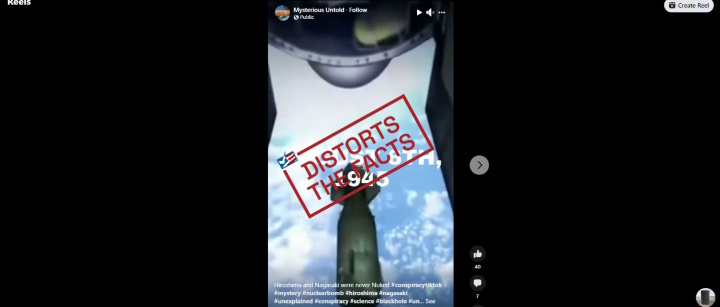
Quick Take
The United States dropped nuclear bombs on Hiroshima and Nagasaki in August 1945, killing hundreds of thousands of people to force Japan’s surrender in World War II. A video on social media falsely claims the cities “were never nuked,” reasoning that nuclear bombs would have made those cities “uninhabitable for thousands of years.”
Full Story
The United States dropped an atomic bomb — a nuclear weapon that releases explosive energy by splitting the nuclei of atoms — on the Japanese city of Hiroshima on Aug. 6, 1945. The uranium bomb, with a force of 13 kilotons, killed an estimated 237,000 people in the explosion or through the subsequent effects, including radiation sickness and cancer.
The U.S. dropped leaflets in parts of Japan warning of the weapon’s destructive power and asking citizens to “petition the Emperor to end the war.”
On Aug. 9, a plutonium bomb with an explosive force of 21 kilotons was dropped on Nagasaki. More than 73,000 people died in that bombing and its aftermath. The following day, Japan told the U.S. it would surrender.
The recently released film “Oppenheimer” focuses on the physicist J. Robert Oppenheimer who led the development of those first nuclear bombs.
Now, in the wake of the movie’s release and the anniversary of the bombings, a video posted Aug. 2 on Facebook makes the false claim that “Hiroshima and Nagasaki were never Nuked.”
The video misleadingly suggests that nuclear weapons could not have been used in Japan. The narration says, in part “These bombs … were plutonium- and uranium-based nuclear weapons. Plutonium-239 has a half-life of 24,110 years and Uranium-235 has a half-life of 703 million years, in theory, making both Hiroshima and Nagasaki uninhabitable for thousands of years. … Are these two cities thriving in a nuclear wasteland? Or, Hiroshima and Nagasaki were never Nuked.”
The radiological half-life refers to “the time required for half the atoms of a particular radioisotope to decay into another isotope,” as explained by the U.S. Nuclear Regulatory Commission. But the half-life of the isotopes Plutonium-239 and Uranium-235 do not determine the length of time the cities would retain dangerous levels of radiation.
The webpage of the city of Hiroshima explains: “The radiation in Hiroshima and Nagasaki today is on a par with the extremely low levels of background radiation (natural radioactivity) present anywhere on Earth. It has no effect on human bodies. …”
“The initial radiation emitted at the moment of detonation [of the bombs] inflicted great damage to human bodies. Most of those exposed to direct radiation within a one-kilometer radius died. Residual radiation was emitted later. Roughly 80% of all residual radiation was emitted within 24 hours. Research has indicated that 24 hours after the bombing the quantity of residual radiation a person would receive at the hypocenter would be 1/1000th of the quantity received immediately following the explosion. A week later, it would be 1/1,000,000th. Thus, residual radiation declined rapidly.”
In addition, the Radiation Effects Research Foundation, a U.S.-Japan cooperative research institute, explains that the bombs dropped on Hiroshima and Nagasaki “exploded at altitudes of 600 meters and 503 meters, respectively, then formed huge fireballs that rose with ascending air currents. About 10% of the nuclear material in the bombs underwent fission; the remaining 90% rose into the stratosphere with the fireball. … [M]ost of the remaining uranium and plutonium was widely dispersed in the atmosphere.”
This is not to say that the radioactive material had no lasting effect on the people living in those cities.
In addition to the deaths from the direct force and heat of the explosions or acute radiation exposure, the bombs’ radiation continued to cause health effects years later. The K=1 Project at Columbia University reported that an increase in leukemia occurred two years after the bombing and peaked four to six years later. Other cancers began to appear 10 years after the bombings.
Scientists are still tracking the health effects of the nuclear bombs dropped on Japan in 1945.
The video on Facebook doesn’t offer any explanation for what caused the magnitude of the deaths and devastation in Hiroshima and Nagasaki.
Editor’s note: FactCheck.org is one of several organizations working with Facebook to debunk misinformation shared on social media. Our previous stories can be found here. Facebook has no control over our editorial content.
Sources
Atomic Heritage Foundation. “Bombings of Hiroshima and Nagasaki – 1945.” ahf.nuclearmuseum.org. 5 Jun 2014.
Bradbury Science Museum, Los Alamos National Laboratory. Atomic vs. Nuclear Weapons. Accessed 9 Aug 2023.
Discover Nagasaki. “About Nagasaki.” Discover-nagasaki.com. Accessed 9 Aug 2023.
Atomic Heritage Foundation. “Warning Leaflets.” ahf.nuclearmuseum.org. Accessed 9 Aug 2023.
U.S. Department of Energy. “The Manhattan Project: An Interactive History. Japan Surrenders.” Accessed 9 Aug 2023.
Dargis, Manohla. “‘Oppenheimer’ Review: A Man for Our Time.” New York Times. Updated 27 Jul 2023.
United States Nuclear Regulatory Commission. “Half-life (radiological).” Nrc.gov. 9 Mar 2021.
City of Hiroshima. “Q. Is there still radiation in Hiroshima and Nagasaki?.” City.hiroshima.lg.jp. Accessed 9 Aug 2023.
Radiation Effects Research Foundation. “Frequently Asked Questions about the Atomic-bomb Survivor Research Program.” Rerf.or.jp. Accessed 9 Aug 2023.
United States Nuclear Regulatory Commission. “Fission (fissioning).” Nrc.gov. 20 Jan 2023.
Listwa, Dan. “Hiroshima and Nagasaki: The Long Term Health Effects.” Columbia University K=1 Project. 9 Aug 2012.
PBS News Hour. “Scientists still track health fallout of nuclear bombing of Japan.” PBS.org. 25 May 2016.
Douple, Evan et al. “Long-term Radiation-Related Health Effects in a Unique Human Population: Lessons Learned from the Atomic Bomb Survivors of Hiroshima and Nagasaki.” Ncbi.nlm.nih.org. 31 Jan 2014.
"lasting" - Google News
August 11, 2023 at 10:37PM
https://ift.tt/MrS071c
Video Misrepresents Lasting Effects of Nuclear Bombs Dropped on Japan During World War II - FactCheck.org
"lasting" - Google News
https://ift.tt/4QjYZdh
Shoes Man Tutorial
Pos News Update
Meme Update
Korean Entertainment News
Japan News Update
Bagikan Berita Ini














0 Response to "Video Misrepresents Lasting Effects of Nuclear Bombs Dropped on Japan During World War II - FactCheck.org"
Post a Comment